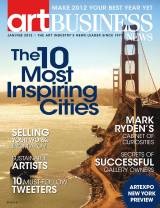As the most requested magazine in the industry, Art Business News stays true to its mission of reporting the latest industry news and emerging trends driving the fine art market. ABN: The art industry's news leader since 1977.
Page 41 of 67
ABN
renaissance similar to what New York City's East Village and SoHo neighbor- hoods experienced in the 1970s and '80s, in the Wynwood Arts District. T is formerly forgotten neighbor-
country's most important art events. Miami's year-round arts community
is as diverse as the city's population it- self. With an electric, eclectic and inter- national vibe, local artists fi nd inspira- tion in the city's one-of-a-kind energy. "Miami is bright and refl ects the
energy it has in every corner," says photographer Malena Assing (www. malenaassing.com). "T e city is full of diff erent colors, textures and the ever- changing light on the beach that sur- rounds the entire state creates a special feeling of freedom." "I will say, as a photographer artist,
it's the light in Miami that makes for a great image," concurs Geoff rey Baris (www.geoff reybarisart.com). "Beauti- ful sunrises over the ocean and exotic fauna. T e large white beaches, soſt blue ocean and sky keep the light from ever being too contrasty. It's the perfect light and climate to create amazing images." From architecture to art, Miami has
always been a forward-thinking locale (look no further than the historic Art Deco buildings that line South Beach's Ocean Drive or the growing number of "starchitect"-designed parking garages). And today it's in the midst of an artistic
hood—which runs from 20th Street to 36th Street, and is bounded by I-95 to the west and Biscayne Boulevard to the east—has be- come the city's artistic epicen- ter, and is now home to more than 50 galleries, four mu- seums and many individual artist studios. T e area even has its own advocacy group, the Wynwood Arts District Association (www.wynwood- miami.com) to help foster its growth and development. Artistry is alive and well in
the Magic City.
Q LOS ANGELES, CALIFORNIA
T ough it's best-known as the center
of the motion picture industry, L.A.'s creativity defi nitely extends beyond fi lm. When it comes to living the art- ist's life in Los Angeles, the numbers don't lie: Approximately 850 museumes and galleries, 2,800 arts organizations and 150,000 self-described "artists" call the City of Angels home. In fact, according to a recent report by the Univer- sity of Southern California's Stevens Institute for Innovation, "there are more artists, writers, fi lmmakers, actors, danc- ers and musi- cians living and working in Los Angeles than
40
attracting artists in the 1970s. T ough high-end developers have moved into the area—attracting wealthy young professionals who are interested in living the "artist" lifestyle, too—relics of the neighborhood's industrial past remain, including a rail yard, cold storage facilities, food processing plants and working warehouses. But the city as a whole has plenty to
off er creative types. T e Los Angeles County Arts Commission promotes understanding and accessibility to the arts by providing information and resources for artists, educators, arts organizations and the public. Major museums—including the Los Angeles County Museum of Art, the Getty Center and the Museum of Contem- porary Art—are some of the country's biggest and wealthiest art institutions. Downtown's Gallery Row, home to 45 galleries, attracts tens of thousands of visitors to its monthly Downtown Art Walk. What else would you expect from "T e Creative Capital of the World?"
JANUARY/FEBRUARY 2012
any other city at any time in the history of civilization." A center point of this artist take-
over is the Downtown Arts District, a 60-block area formerly known as the Warehouse District, which began
